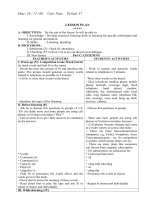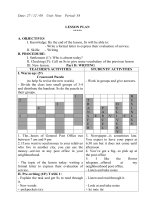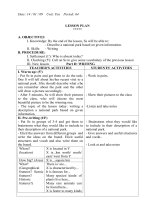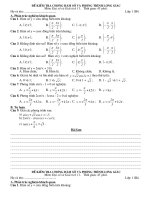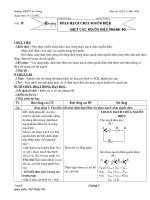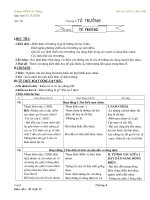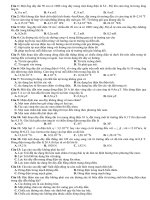10376 11b
Bạn đang xem bản rút gọn của tài liệu. Xem và tải ngay bản đầy đủ của tài liệu tại đây (1 MB, 18 trang )
Previous Page
Bt genes have been introduced into potatoes, cotton, maize, and other
plants. The action mechanism is similar as described for Bt itself.
The class II EPSP synthase gene also called roundup ready gene
induces tolerance to glyphosate. When introduced into soybeans, cotton,
maize, canola, and the like, these plants tolerate glyphosate. That means
that glyphosate can be used to control weeds in these crop plants without damaging them, although it is originally a total herbicide that kills
all plants.
The advantage for the farmer is that he needs only one product, instead
of several different selective (and more expensive) herbicides. Roundup
ready soybeans were launched in 1996 and today 50 percent of the soybean crop in the United States is derived from roundup ready seeds.
Other glyphosate-resistant transgenic crops introduced by Monsanto
are maize and oil seed rape. Competing companies also developed herbicideresistant plants or plants genetically modified to be protected against certain pests, but none has achieved a commercial breakthrough, mainly
because of political reasons.
One controversial issue is that the farmers must buy transgenic seeds
that are controlled by one monopolist supplier. Local seed suppliers
cannot produce seeds from harvested crops, because the transgenic
plants are sterile and unable to produce new seeds for germination.
Another potential problem is that the resistance genes of the transgenic plants are released into the environment in an uncontrolled way
leading to problems that are presently not foreseen. The European
Union has put a ban on all new transgenic plants and requires a clear
labeling of all food that contains products from transgenic crops.
Europeans feel that it is an unacceptable risk, as it is not proven that
genetically modified food is safe. Many Americans on the other hand
think that this is no problem at all, as there is no proof that genetically
engineered food is not safe. This illustrates the different perceptions of
risk in different parts of the world.
11.5 Testing Requirements for New
Pesticides
11.5.1 General information and physical
and chemical properties
In the past, pesticides were optimized for efficacy, but sometimes with
harmful side effects to man or the environment. Today, modern pesticides have high selectivity for the target organism, and testing programs are mandatory to minimize risks and maximize benefits. Before
a pesticide can be sold, the supplier must ask the competent authorities of the respective countries for a permit, the marketing authorization. The applicant must submit a dossier containing all information
about the new substance that is needed to make a thorough risk or benefit analysis. A complete registration dossier contains around 200 different scientific reports with over 20,000 pages, the equivalent of
25 books. The studies are conducted under stringent quality control
following the OECD guideline of GLP (Good Laboratory Practice). GLP
is an internationally accepted quality standard. It assures that the personnel are qualified, that the methods are validated and that the instruments are properly calibrated. All data and reports are audited by an
independent quality assurance unit.
The first part of a dossier contains basic information about the active
substance and the applicant. Here are some examples: name, structure,
and route of synthesis of the substance must be described. The typical
purity of the technical material and the identity isomers and impurities
is determined by the analysis of five production batches to assess the
reproducibility of the process and to help to identify fake products. In
the next chapter the chemical and physical properties are described,
determined according to official guidelines published by the OECD and
other organizations. This applies to the active substance, all significant
metabolites, and all formulated products. Some of the required studies
are listed in Table 11.11.
TABLE 11.11 Examples of Physical and Chemical Tests Required for the
Registration of New Pesticides
No.
Description of test
Purpose of test or remarks
1
2
3
4
Appearance (physical state, color, odor)
Melting point, boiling point, density
Vapor pressure
Flammability, explosivity, corrosivity,
oxidative properties
Surface tension
Solubility in water (at 3 pH values) and
organic solvents
Spectra (UV/VIS, IR, NMR, Mass)
Partition coefficient n-octanol or water
Hydrolysis and photolysis in water
Stability and photochemical
degradation in air
Stability upon storage or shelf life
Analytical methods for purity
and impurities in active
substance and products
Analysis of five production batches
Analytical methods for residues in food
Analytical methods for residues in
soil, water, air
Identification
Identification, information
Risk for evaporation
Hazard during transport and
storage
Risk to surface water
General information,
risk for leaching
Identification
Risk for bioaccumulation
Risk for persistence
Risk for air pollution, persistence,
and ozone depletion
Quality of product
Quality and risk of
toxic impurities
5
6
7
8
9
10
11
12
13
14
15
Reproducibility of process
Consumer safety
Environmental monitoring
Appearance, melting and boiling points, density, spectra, and solubility data serve to establish unambiguously the identity of the substance. The vapor pressure value is an indication of the volatility of the
substance. If a substance is volatile it may evaporate and be transported through air and inhaled by people, thereby increasing the risk
to bystanders or nontarget plants. Flammability and explosivity are
also safety parameters that show whether a substance may be dangerous when shipped or stored.
The partition coefficient is a very important property to assess possible accumulation of a substance in the food chain. It is defined as the
ratio of the solubility of a substance in n-octanol and in water.
Log (Kow) = log [(concentration in octanol) / concentration in water)]
A high log (Kow) means that the substance dissolves better in octanol
than in water (e.g., if log Kow = 6, a million times). In practical terms
this means that there is a risk that the substance accumulates in fat.
On the other hand, a log (Kow) < -2 shows that the substance is a hundred times more soluble in water than in octanol. This usually is a
warning sign that the substance has a tendency to leach into ground
water.
Hydrolysis and photolysis experiments allow conclusions on how
stable a substance is and whether it may have a tendency to persist in
the environment. Here the rate constants and the half life of a substance in water are measured at different pH values and under irradiation
with simulated sunlight. The hydrolysis is tested at four different pH
values: pH 4, pH 7, and pH 9 simulate the natural situation in soil and
water, while a pH 1.2 is used to simulate the acidity in the stomach and
gives some indication about hydrolysis after accidental oral ingestion.
Organochlorines are often stable against hydrolysis. Other compounds
undergo complicated reactions leading to a variety of products that are
difficult to analyze. Methyl bromide is a compound that undergoes a
straightforward hydrolysis resulting in the formation of methanol and
hydrogen bromide (Eq. 11.7).
pH4
CH3Br + H2O ——* CH3OH + HBr
(11.7)
The storage stability (shelf life) of active substances and formulated
products are studies under simulated climatic conditions to assure that
they maintain their quality when stored or transported. A product must
be stable for at least 2 years under the conditions on the climatic zone,
where it is used.
The efficacy chapter contains the information directly related to the
use of the active substance in the field, like mode of action, intended use,
application rates, frequency of applications, efficacy against target
organisms, and potential for development of resistance in target organisms. Efficacy must be demonstrated for all target organisms and for all
formulations intended for marketing. Efficacy is evaluated in field studies under different climatic conditions. Studies are conducted by specialized field trial contractors or by government affiliated agricultural
research stations.
In all tests, the chemical analysis of the samples is a crucial step.
Modern chromatographic methods are applied, for example, HPLC, LCMS-MS, or GC-MS and all methods must be carefully validated. This
means that linearity, accuracy, precision, and selectivity must be proven.
Validations are required for methods used during the development phase
and also for monitoring after a marketing authorization is granted.
Enforcement methods are intended for use by government laboratories
to monitor product quality, worker exposure, or residues in food, feed,
and the environment.
11.5.2 Toxicity
The toxicity of pesticides (and all other new chemical products) must be
tested on animal models before a product can be sold in the market.
Toxicity tests have different levels of complexity and different objectives. Acute toxicity studies are usually carried out on rats and the effect
lasts up to 7 days. Their purpose is to determine how toxic a substance
is after accidental exposure. Tests are conducted not only through oral
intake and inhalation, but also through exposure to the skin and eye.
The latter test was originally done on rabbits, but is now being replaced
by in vitro alternatives. The final result (end point) of the acute oral tests
used to be the LD-50 value, the dose after which 50 percent of the animals die. It is now being replaced by the acute reference dose (ARfD).
This is the highest dose that is still safe for a human after a single
exposure to the pesticide. It is calculated from the highest dose that
caused no harm in the acute animal studies (NOAEL = no observed
adverse effect level) and a safety factor (F). The safety factor is usually
100 and it accounts for the uncertainty that is associated with the comparison of the toxic responses in animals and humans.
ARfD = NOAEL (in acute studies) * safety factor (F)
Short-term toxicity studies simulate the exposure of workers or
farmers to the products they use on a regular basis. They are performed with rats and dogs and last 1 to 6 months. Chronic and carcinogenicity studies last up to 2 years and simulate the long-term
exposure of consumers to small concentrations of pesticides in food.
Rats, mice, and dogs are used as animal models. The final result is the
acceptable daily intake (ADI), the highest exposure level that is still
safe for humans.
ADI = NOAEL (in chronic studies) * safety factor (F)
ADI and NOAL are given in mg/kg (body weight). That means they
are normalized to the body weight to make the results of different species
comparable.
Absorption, distribution, excretion, and metabolism (ADME) is a
test to establish the fate of a substance in the body of a living organism. This study type is also used to investigate the transfer into secondary products such as milk and eggs. Animal models for ADME
studies are rats, goats, and hens. Distribution of the original active
substance (parent) in the different organs is determined and the
formed metabolites are identified and quantified. The final result is a
mass balance accounting for the fate of the applied substance, for
example, how much is excreted via exhaled air, urine, or feces and
how much stays in the body. C-14 labeled test substance is often used
for this type of study, because radioactivity can be followed more easily
than unlabeled substances.
11.5.3
Residues in food
Food safety is a key issue in modern society, because we are exposed to
food from birth to death. Plant protection products are often used on food
crops, biocides in food factories, or animal housing. Therefore, tests are
required to determine the risk of pesticide residues in the raw agricultural commodity (RAC) and the processed food products.
The first step is to identify the critical crops and the compounds for
which residue studies must be conducted. The breakdown and reaction
products and metabolites in treated plants and products are often identified after treatment with a C-14 labeled test substance in plant metabolism studies. The objective is to determine the fate of the parent
substance and its metabolites in the crop plants and their processing
products. From the results of the studies, the relevant residues are
defined {residue definition). For example, in plants glyphosate is converted to its main metabolite AMPA (= aminomethylphospohonic acid),
which was also studied as part of the residue assessment.
metabolism
Glyphosate
After the significant residues are identified, field studies are designed
to determine experimentally the level of residues in crops that were
treated according to the label recommendation and to good agricultural practice. Field trials are required in typical growth areas and in
different climate zones. The program must be repeated in a second
year to account for climatic fluctuations. Samples of the crop and the
processed food are collected at various intervals after application of the
pesticide and at the normal harvest day. They are deep-frozen to < -20 0 C
to avoid degradation of the residues and sent to the analytical laboratory, where they are analyzed for residues of all compounds included
in the residue definition. The result is a maximum residue level (MRL),
the concentration that will not be exceeded when a product is used
exactly as recommended by the manufacturer. If a higher concentration
is found in a crop, it can be concluded that the farmer did something
wrong. However, residues >MRL do not mean that the food is unsafe,
because the MRL is usually much lower than the level that would affect
the health of the consumer. Only if a residue exceeds the ADI (acceptable
daily intake), the food poses an unacceptable health risk.
11.5.4
Human safety risk assessment
Risk, in its scientific meaning, has two components, namely hazard and
exposure. To swim in an ocean is hazardous, but people living inland
are never exposed to swimming in the ocean. This means that their personal risk of being harmed by the ocean is very small.
Risk = hazard x exposure
The hazard of pesticides comes from their toxicity, exposure from their
use, or from residues in food. In principle every person can be exposed
to pesticides, therefore, a large number of toxicity tests must be conducted
before a pesticide gets a marketing authorization. (See Table 11.12 for
examples.) The toxicity of pesticides varies widely, as can be seen from
the examples in Table 11.13. On acute exposure glyphosate, nicosulfuron, and mancozeb are essentially not toxic, whereas carbofuran is
very toxic. It is 50 times more toxic than imidacloprid, which has a similar use. On the other hand, the application rate of carbofuran is three
times higher than that of imidacloprid. If we assume that the exposure
of farm workers parallels the application rate, the exposure to carbufuran is three times that of imidacloprid. Three times higher exposure
together with 50 times higher acute toxicity leads to 150 times higher
risk for workers using carbofuran than for workers using imidacloprid.
Chronic toxicity does not parallel the acute toxicity. Chlorpyriphos
and paraquat for instance, have medium acute toxicity, but a high
TABLE 11.12 Examples of Toxicological Tests Required for the Registration of a
New Pesticide
Animal
model
No.
Description of test
1
Acute oral and inhalation
toxicity
Acute dermal toxicity
Skin and eye irritation,
sensitization
Short term toxicity up
to 6 months
Long-term toxicity and
carcinogenicity up to 2 years
Reproductive toxicity
2
3
4
5
6
7
8
Neurotoxicity, endocrine
disruption
ADME (adsorption,
distribution metabolism,
and excretion studies)
Rat
Rat
Rat, rabbit
in vitro
Rat, dog
Rat, dog,
mouse
Rat, rabbit
Rat, hen
Rat, goat
hen
Purpose or remarks
Accidental ingestion or
inhalation
Accidental exposure or skin
Damage of eye or skin after
accidental exposure
Risk after multiple exposure
(workers)
Risk upon lifetime exposure
(consumer via food)
Risk for fertility and exposure
during pregnancy
Risk to nerve and hormone
systems
Assessment of fate in the body
and the risk of transfer to
milk or egg
chronic toxicity as can be seen from their low NOAEL values. A NOAEL
value of 0.1 mg/kg/day means that test animal exposed to this dose did
not show negative health effects. Only after the intake of higher doses
were adverse reactions observed. The ADI is the maximum amount
that is safe for human intake. It is derived from the NOAEL and a
safety factor.
For example, the NOAEL of glyphosate is 400 mg/kg/day and the ADI
is 0.1 mg/kg/day. This means that human beings with 60-kg body weight
can eat 6 mg glyphosate without risk for their health. This is the toxicity
TABLE 11.13 Oral Toxicity of Some Common Pesticides (Approximate Values)
Compound
Acute tox
LD50 (rat)
(mg/kg)
Chronic tox
NOAEL (rat)
(mg/kg/day)
ADI or RfD
(mg/kg/day)
Application
rate
(g/ha)
Glyphosate
Nicosulfuron
Mancozeb
Imidacloprid
Carbofuran
Chlorpyrifos
Paraquat
2,4-D
>5000
>5000
>5000
424
8
2680
112
640
400
1000
5
6
20
0.1
0.6
5
0.1
1.25
0.03
0.06
0.002
0.01
0.005
0.01
3000
50
8000
290
1000
600
500
1000
ADI = acceptable daily intake; RfD = reference dose
SOURCE: J. T. Stevens (2001).
consideration. Consumers are exposed to pesticide via food. Assuming
a residue of 1 mg glyphosate per kg bread and a consumption of 0.5 kg
bread per day, the exposure is 0.5 mg/day. This is well below the acceptable intake of 6 mg/day, indicating that the risk of consuming bread with
glyphosate residues is low.
The situation is different for paraquat, which has an ADI of
0.005 mg/kg/day. Taking the 60-kg person as an example, the acceptable intake is 0.06 mg/day. On the exposure side, let us assume a residue
of 0.2 mg/kg in bread and a daily consumption of 0.5 kg. This leads to
an exposure of 0.1 mg/kg, which is about twice the acceptable intake.
The conclusion is that, in this example, the risk associated with the
residues of paraquat is not acceptable.
In general, risk values <1 are considered acceptable, while values >1
are not acceptable and require risk management. The risk management must reduce either exposure or toxicity. The latter would mean
that a toxic substance is replaced by a different, less toxic compound.
Exposure can be reduced in different ways. Protective clothes for farm
workers, such as gloves, goggles, overalls, and boots, are well-known
risk management tools that reduce exposure by preventing dermal or
oral intake of the pesticide. Another way to manage risk is to limit the
use of a pesticide. For instance, an insecticide may not be allowed on
food crops, because high residues and chronic toxicity would lead to an
unacceptable risk. Its use for vector control in nonagricultural areas
could be acceptable, because exposure through food is not important.
The concept of risk is a valuable tool to make responsible and scientifically sound decisions. By definition risk is never zero. It must be
balanced by a benefit to make it acceptable.
11.5.5 Environmental fate and
environmental toxicology
All pesticides that can come into contact with the environment are subject to a risk assessment. The basis for this risk assessment is provided
by data from environmental fate and environmental toxicity studies,
which are carried out in the laboratory or under field conditions. The
fate (adsorption, degradation, and mobility) of the active substance
must be studied in soil, air, water, and sediments. The laboratory studies are frequently performed with 14C-labeled substances to make the
mass balance easier. It is important to know how a substance degrades
in the environment, because sometimes the degradation products are
more persistent than the parent substance. DDT, for instance, is converted to metabolites by stepwise dechlorination (Eq. 11.9).
The metabolites (e.g., DDD or DDA) can be found in soil for many
years after the DDT itself is degraded.
Examples of environmental fate studies:
Adsorption and desorption equilibrium constants are determined in
different soils. The route and rate of degradation in water, sediments,
and soil is studied under aerobic, anaerobic, and photolysis conditions
and at different temperatures in the laboratory under standardized
conditions. If the experimental results show that there is a risk for
leaching, semi-field and field studies become necessary. Lysimeter is
the name of a set-up, in which intact soil cores (e.g., 1-m diameter and
1-m depth) are installed in a container that allows collecting the water
that leaches through the soil core. This water (leachate) is analyzed for
content of parent substance and metabolites. If any substance exceeds
a concentration of 100 ng/1 (= 0.1 ppb), high risk for leaching is established
and the substance cannot be used in the field. Also, here the formation
of degradation products must be taken into account. They are often
more polar than the parent and are therefore more soluble in water. This
can lead to higher mobility. Atrazine is a typical example. The parent
molecule has already a tendency to leach into groundwater where it has
a half-life of 100 to 200 days. Its metabolite desethylatrazine (DEA, Eq.
11-10), however, is even more soluble and moves more readily through
the soil. Its high mobility was so much of a concern that atrazine was
banned from use, in which it can come into contact with groundwater.
Atrazine
Field soil dissipation and accumulation studies are carried out to
determine the lifetime of a substance in soil and to see whether it has
a tendency to accumulate. The final result is the DT-90 value. This is
the time after which 90 percent of the starting material has disappeared.
TABLE 11.14 Environmental Fate and Environmental Toxicity Studies Required for
the Registration of Pesticides
No.
Description of test
1
4
Rate and route of
degradation, laboratory
studies
Field soil dissipation and
accumulation studies
Column leaching, lysimeter,
field leaching
Toxicity to aquatic life
5
Toxicity to birds
6
Toxicity terrestrial life
7
Effects on nontarget
arthropods
2
3
Test system
Soil, sediment,
water
Soil
Soil, ground water
Purpose or risk
Persistence, formation of
dangerous degradation
products
Persistence, accumulation
Mobility in soil, leaching
into ground water
Interruption of food chain
Fish, daphnia, algae,
microorganisms
Quail, duck
Accumulation in food
chain
Interruption of and
Earthworm,
accumulation in food chain
microorganisms
Protection of nontarget
Honeybees,
species
predatory mites
If the DT-90 is longer than 3 months, there is a risk for accumulation
and risk management procedures must be proposed. One such procedure
could be to apply a product only every second year.
The second component of an environmental risk assessment for plant
protection products that can come into contact with the environment
are environmental toxicology tests (Table 11.14). Toxicity to aquatic
life is tested on bacteria, daphnia, fish, and algae representing the food
chain of aquatic species. Toxicity in terrestrial systems is studied with
microorganisms, earthworms, nontarget plants, and other soil-dwelling
organisms. Birds and mammals that feed on worms, fish or treated
plants are the last step in the food chain. They are also included in the
environmental toxicity program. Toxicity to beneficial insects is tested
to assess the risk for nontarget species. Toxicity to honey bees is critical, as they are required to fertilize flowering plants and trees.
Sometimes it is not possible to make insecticides so selective that they
kill pests (insects) but not honeybees. In this case, the risk management provision is to avoid using the product during the honeybee season
or on flowering plants.
The evaluation of the results from the environmental fate leads to a
predicted environmental concentration (PEC) of the pesticide representing the exposure level. The accumulation in the food chain of fish
is expressed as BAF (bioaccumulation factor in aquatic environment),
that of mammals and birds as BCF (bioconcentration factor in terrestrial
environment). Accumulation increases the exposure. The NOAEL (no
observed adverse effect level) represents the hazard level. It is the result
of the environmental toxicology studies. If the PEC is higher than the
NOAEL multiplied by a safety factor, the risk is considered too high and
the pesticide is not registered (see Table 11.14).
11.6
Social and Economic Aspects
11.6.1 Social consequences of
pesticide use
The benefits of pesticides are social and economic. Social components are
human health, availability of food, quality of life, and protection of the
environment. Economic factors are loss of harvest, profitability of agriculture, and revenue of the industry. Some social factors are directly
related to economic factors. If a farmer cannot make a living on his
farm, he and his family must leave the land and migrate to the city, a
process that occurs very frequently everywhere in the world. If the agrochemical industry does not make a profit, the factories must close down
and the employees lose their jobs. If food becomes scarce prices go up
and people with low incomes cannot afford a balanced diet or may even
starve.
From these statements it seems clear that we need pesticides, if we
want people to lead a decent life. There are, however, also a lot of social
problems connected with pesticides. All pesticides are, by definition,
toxic to some living organism—insecticides to insects, herbicides to
plants, fungicides to fungi, and so on. In addition, they often have direct
or indirect effects on nontarget organisms. Some are more toxic or
longer lasting than others. Some accumulate in the environment and
cause harm far away from the original site or purpose of application.
No pesticide can be considered safe. Risks associated with the use of a
pesticide must be outweighed by the benefits.
The perception of risks and benefits changes with time as the history
of DDT illustrates. DDT was first synthesized in 1874 by the German
chemist Zeidler. However, the insecticidal properties of DDT were discovered only later, in 1939, by Paul Mueller in Switzerland, who
received the Nobel Prize for his discovery. After it became available on
the market, DDT was accepted immediately and used on a large scale.
For the first time in history, people could control insects effectively.
Mothers could relieve their children from lice, farmers could protect
their livestock and harvest. DDT has probably been responsible for
saving more lives than any other synthetic chemical, perhaps with the
exception of antibiotics. It is estimated that around 1940 ca 300 million
people suffered from malaria. The mortality rate was about 1 percent.
Thirty years later DDT and WHO (World Health organization) malaria
program had eradicated malaria in many parts of the world. DDT also
controlled the vectors of other diseases, such as louse-borne typhus, the
plague, yellow fever, viral encephalitis, cholera, and the like.
Around 1970, people discovered that DDT benefits had their price. It
is persistent in the environment and had accumulated over the years
following its intensive use. Birds and aquatic life were directly affected,
humans indirectly through DDT accumulation in the food chain. It
deemed that risks outweighed the benefits and DDT was banned from
most uses. Other seemingly less harmful insecticides had become available and replaced DDT. At the time organophosphates and carbamates
were believed to be better alternatives, because they did not bioaccumulate. Today, we know that they are often very toxic to humans and
animals. They harm the operators, when applied without proper protection, and they are the cause of many accidental poisonings. Actually,
they are to a large extent responsible for the bad reputation that pesticides have today. The next step was the use of pyrethroids. They were
effective and their use had relatively low risks, but the insects developed
resistance, leaving us with a new problem. This shows how sometimes
a known risk is simply replaced by another risk, often unknown at the
time of the introduction of the product.
There is also a big gap between real and perceived risk. In Europe and
the United States the public is mainly concerned about residues and food
safety. With proper precautions, however, this is not a real problem, as
residues in food are low and do not contribute significantly to our total
intake of chemicals. Actually, there are no cases confirmed in which
residues of modern pesticides in food were the cause of poisoning of
humans. As there is a large overproduction of agricultural commodities
in western countries, people worry about minor risks, like pesticide
residues, as they do not have to worry about supply of food in principle.
The picture is strikingly different in other parts of the world, where food
production does not match the growth of the population and where malnutrition and famine are well known.
The largest real risk of pesticides is associated with their use. Farm
workers and their families are often poisoned by pesticides as a consequence of improper protection during application. A picture of a farm
worker spraying a field with bare feet and hands, without eye protection, wearing his everyday clothes illustrates this (Fig. 11.4). He holds
the nozzle right in front of him and walks directly into the spray mist.
The cotton face mask is not of much use, because it was designed to
retain bacteria and other large particles, not vapors or aerosols. Also,
there is skin exposure and inhalation. His clothes absorb large amounts
of pesticide product. When he gets home, he takes home the pesticide
and may expose his family and food supplies. What a difference to the application methods (see Fig. 11.5) used in modern farming. Here the worker
is wearing protective clothing and spraying behind himself. He will
Figure 11.4 Worker is applying pesticide without protection. The
face mask does not protect against vapors and aerosols. The skin is
directly exposed and neither goggles nor protective clothes are worn.
(Source: Courtesy of Gerald R. Stephenson, University of Guelph.)
(hopefully) remove his disposable garment before going home. Improper
application methods are the main reason for acute and chronic poisoning by pesticides. The challenges are to develop better methods, applicable to hot climates and small farms, and to train the farm workers how
to use them.
11.6.2
Economic aspects
The global crop protection market for the year 2000 was about US$32
billion. Herbicides accounted for about 45 percent, insecticides 22 percent,
and fungicides 20 percent of worldwide sales. The top selling agrochemicals were glyphosate and paraquat as herbicides, chlorpyriphos
and imidacloprid as insecticides, azoxystrobin and mancozeb as
fungicides. The most important uses were on cereals (except rice) with
Figure 11.5 Proper application technique: The operator wears a gas
mask, goggles and a protective coverall. (Source: Courtesy T. Kratz,
Landis Kane Consulting, Switzerland.)
26 percent, fruits and vegetables 22 percent, rice 11 percent, soy beans
10 percent, cotton 10 percent, others 21 percent. In terms of mass, the
production of organic crop protection chemicals grew until 1980. Since
then it is more or less constant, although the treated areas and number
of applications are still increasing. However, the amount of pesticide
applied per hectare is decreasing, as the products become more efficacious and pest management procedures change. The average application
rate in 1980 was 3 kg a.i./ha/treatment; for modern pesticides it is less
then 0.3 kg a.i./ha/treatment (a.i. = active ingredient). Nevertheless,
altogether about 1 million t of active ingredients are produced worldwide
every year. The sales of the different pesticide classes is illustrated in
Figs. 11.6, 11.7, and 11.8.
The development of new pesticides is very expensive and costs more
than US$100 per substance and the failure rate is high. It takes 5 to
8 years from the time of discovery to bring a new substance to the market.
On the other hand, only the best-selling products have sales exceeding
US$100 per year. On average, new substances are patent protected for
another 10 years after they are brought to the market. Thereafter they
can be produced by any company with much lower development cost and
therefore at lower prices. Off-patent compounds produced by nonresearch companies are called generics or generic products.
Others 13%
Herbecides
Fungicides
Insecticides
Figure 11.6 Sales of the most important crop protection
chemicals. {Source: Cramer, H.H., 2003.)
Generics are low-cost alternatives to new substances and are widely
used in many parts of the world. The problem is that many generics are
still used in Asia, Africa, Eastern Europe, and South America, which are
banned in economically advanced countries, because of unacceptable
risks. According to UN Food and Agriculture Organization (FAO) and
World Health organization (WHO), about one-third of the pesticides
sold in the developing countries, representing a market value of
US$900 million, do not comply with international regulations. Those
low-quality pesticides often contain hazardous active compounds or are
impure. In 2000, of the pesticide sales of US$32 billion worldwide, the
Europe
North America
Rest of the world
East Asia
Latin America
Figure 11.7 Regional distribution of crop protection
product sales (2002). (Source: Castle, D., 2003.)
Billion US $
Conventional
Biotech
Figure 11.8 Global sales of conventional and biotech crop protection (in
billion US dollars at distributor level). (Source: Uttley, K, 2003.)
Poor countries
Population
% change over decade
Yield
Population
Yield
Rich countries
% change over decade
Yield
Population
Population
Figure 11.9 Comparison of agricultural productivity and population
growth in poor and rich countries. In poor countries the population
grows faster than the yield per hectare; in rich countries it is the
opposite. (Source: Castle, D., 2003.)
market share of developing countries was just $US3 billion or about
10 percent. The reason for this imbalance is economic. Many farmers in
poor countries cannot afford modern efficient pesticides, although they
would need them urgently. This is illustrated in Fig. 11.9. In the poor
countries the population and the yield per hectare grew at about an
equal rate in the 1980s. In the 1990s, however, the population grew
more rapidly than the agricultural production. If this does not change
soon, the next food crisis is inevitable. In the rich, rapidly developing
countries, on the other hand, productivity increases faster than population, leading to overproduction and to economic problems for farmers.
The most obvious solution to the problem would be to import food from
countries with overproduction to those with food deficit. However, this
is not feasible, because the cost of transportation is too high.
Bibliography
Anderson, T. M., Industrial fermentation processes, Encyclopedia of Microbiology, Vol. 2,
Academic Press, 2000.
Appleby, A. P., F. Muller, and S. Carpy, Weed control, in Ullmann's Encyclopedia of
Industrial Chemistry, 6th ed., Vol. 39, p. 199, 2003.
Castle, D., in Registration of Agrochemicals in an Enlarged Europe, HR Conference,
Brussels 2003.
Copping, L. G. (Ed.), The BioPesticide Manual, British Crop Protection Council, 1998.
Cramer, H. H., Crop protection, in Ullmann's Encyclopedia of Industrial Chemistry,
6th ed., Vol. 9, p. 677-700, 2003.
Hirose, Y., Production and isolation of enzymes, Enzyme Catalysis in Organic Synthesis,
Vol. 1, 41-66, Drauz, K., and Waldmann, H. (Eds.), Wiley-VCH, Weinheim, Germany,
2002.
Huber, D., J. Jeong, and M. Ritenour, Use of 1-Methylcyclopropene (1-MCP) on Tomato
and Avocado Fruits, Potential for Enhanced Shelf Life and Quality Retention, Document
HS-914, Florida Cooperative Extension Service, Institute of Food and Agricultural
Sciences, University of Florida. Available at EDIS Web site, ,
January 2003.
Maisch, W. F., Fermentation processes and products, Corn Chemistry and Technology,
2nd ed., White, P. J. and Johnson, L. A. (Eds.), AACC Monographic, 695-721, 2003.
Notermans, S. and F. Rombouts, (Eds.), Frontiers in Microbial Preservation and Fermentation,
Elsevier Science Ltd., Oxford, 2002.
OECD, Guidelines for the Testing of Chemicals, ISSN 1607-310X, 2002, available at
www.sourceoecd.org.
Praeve, P., U. Faust, W. Sittig, D. A. Sukatsch (Eds.), Handbuch der Biotechnologie,
Akademische Verlagsgesellschaft, Wiesbaden, 1982.
Sanchez, S., and Demain, A. L., Metabolic regulation of fermentation processes, Enzyme and
Microbial Technology, 31, 895-906, 2002.
Stephenson, G. R., Pesticides use and world food production: Risks and benefits, Chap. 15,
261-270, in Environmental Fate and Effects of Pesticides, J. R. Coats, Coats and H.
Yamamoto (Eds.), Symposium Series 853, American Chemical Society, Washington, DC.
Stevens, J. T. and C. B., Breckenridge, Crop protection chemicals, in Principles and Methods
of Toxicology, 4th ed., A. W. Hayes, (Ed.), Taylor & Francis, Philadelphia, 2001.
Synthesis and Chemistry of Agrochemicals VI, ACS Symposium Series No. 800, American
Chemical Society, 2002.
Tomlin, C. D. S. (Ed.), The Pesticide Manual, 12th ed., British Crop Protection Council,
2000.
Uttlejf, N., in Registration of Agrochemicals in an Enlarged Europe, HR Conference,
Brussels, 2003.
Vert, M., Polymers from fermentation, Poly(lactic acid)s and their precursors, the lactic
acids, Actualite Chemique, 11, 12, 79-82, 2002, (in French).
Waites, M. J., N. L. Morgan, J. S. Rockey and G. Higton, Industrial Microbiology, Blackwell
Scientific, Oxford, 2001.
Internet sites with information about agrochemicals:
www. europa. eu. int/publications/en
www.epa.gov/pesticides
www.pesticides.gov.uk
www.wwf.org
www.oecd.org/document
www.fao.org
